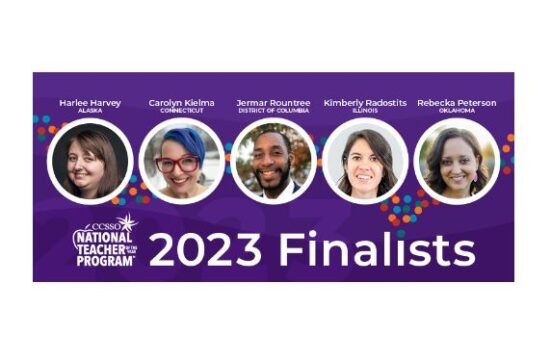The Council of Chief State School Officers has selected five finalists for National Teacher of the Year from a cohort of 55 educators. The winner will be announced in the coming weeks.
High-school science teacher Carolyn Kielma is the 2023 Connecticut Teacher of the Year. SmartBrief interviewed her about helping students feel valued, treating them with equity and the challenges that teachers are facing.
This Q&A has been lightly edited for clarity and space.

Carolyn Kielma has blue hair. Some students at Bristol Eastern High School in Connecticut try to convince her to dye her tresses a different color, but the science teacher says she likes blue.
“And our school colors are blue,” Kielma says with a laugh.
A veteran of more than 20 years in teaching, Kielma says relationships are extremely important to being an effective teacher. Connecting with students on a personal level is critical to success, she notes.
“I like to say, I couldn’t teach them if I can’t reach them.”
Reaching students includes 13 years teaching, and now leading, the school’s Advancement Via Individual Determination, or AVID, program. Kielma is one of four AVID teachers, one for each grade level. The teachers work with the same group of students from freshman through senior year, similar to the process of looping, building a strong bond.
Kielma, who says she’s seen three cohorts of students graduate in her 13 years, says the elective class is intended for students who are “in the middle” and get B’s and C’s, but may not see themselves as college material for various reasons, including an absence of college graduates in their families.
With field trips to visit colleges and tutoring support for those taking honors and Advanced Placement courses, the class aims to help students see the potential that Kielma and others see in them.
“Talk about connections to build,” says Kielma, noting that the students and their teacher become a family within the school during those four years together.
If chosen as National Teacher of the Year, Kielma says she wants to focus on educator support, especially for educators who are at the beginning of their careers, during this “tough time for teachers.”
“First-year teachers really struggle,” she says. “It’s really important to support new and rising educators, to nurture that pipeline.”
Kielma says she “couldn’t afford to just be a teacher,” so she had to bartend and wait tables to pay her rent, cutting into the time she needed to prepare to teach her students.
Kielma also says more diversity is needed among teachers, across all demographics, because students need to see themselves in the adults in the classrooms and hallways of their schools.
With her shock of Smurf-shade-of-blue hair, Kielma says she hopes students can see themselves in her and realize that “it’s OK to be unique and different. It just shows you can be who you truly are and be successful.”
SmartBrief: A lot is asked of teachers in the US, often without getting a lot in return (whether pay, recognition or support). What can school districts and/or principals do to help teachers who are tapped out, retain educators and recruit new ones when the job can sometimes seem so overwhelming?
Kielma: This is a very difficult question. It is vital for districts to extend mental health support to faculty and staff, as well as to students. Many teachers are dealing with empathy fatigue from the work we’ve been doing to help students since 2020 (at the beginning of the pandemic).
It is also important for teachers to have the ability to design personalized professional development and be allowed choices of which training they need.
Standardizing salaries across school districts would also help to balance the shortage so underserved communities do not suffer.
To recruit and retain educators, the teacher preparatory programs need updating. For example, when student-teaching, many education majors cannot have an outside job, as this takes all their focus, time and energy. Perhaps a stipend would help those teachers stay in the field. Loan forgiveness for educators who sign contracts with schools could also be an option. We know that new teachers who reach their third year have a 95% retention rate, so we need to focus on partnering new teachers with strong mentors or even hire respected/retired teachers to mentor them during those crucial novice years. Support and collaboration is essential for educator retention.
SmartBrief: We hear so much about teachers who want to make all students feel valued and gifted and capable of great things, and the importance of connecting with them — learning about a student’s home life, going to their sports or extracurricular activities. Do you have tips for ways to do this that won’t encroach into a teacher’s personal time or that have some out-of-the-ordinary ways to connect?
Kielma: At the high-school level, my district adds an advisory period to our regular schedule. This is a short break in the day, often like a homeroom class, where students meet with the same teacher daily for all four years of their high school education. This allows students to create meaningful relationships with at least one trusted adult during their time here.
We have extended advisory time at the middle of each week to really work on social and emotional learning skills, community service initiatives, or other schoolwide goals. It is a great way of helping each student to focus on their unique needs.
In the classroom, each teacher has their own way of connecting with students. One of the many things I do is to have students write at the beginning of the period. In these “learning logs,” students write daily to reflect about what they learned last class, what they still need to learn, what they wonder about, and finally, a section that reads “Today I am feeling…,” where students can simply draw an emoji or face showing where they’re at or write in words to explain where their emotional state is or how they’re showing up to class. I walk around the room checking that specific section to know who I need to give some space and grace or who I should check in with more often.
SmartBrief: Behavior problems seem to have increased among students since the beginning of the pandemic, but this issue has always existed. What are your classroom management strategies for dealing with disruptive behavior and regaining control of the room? Is it different now than in the past?
Kielma: What I do in the beginning of the year to build trust and relationships is essential to creating a safe and productive classroom environment. I work to make sure all students feel that they have a voice in my classroom. My goal each year is to build an emotional connection with each student. Personally, I need to start there.
Once that foundation is built, I find that many of those issues simply do not happen in my classroom. If they do, I am able to speak to the student with the shared and mutual respect I have been nurturing.
SmartBrief: Collaboration with peers and administrators seems like a thread that ties together all the National Teacher of the Year finalists. What does successful collaboration look like? What are your favorite collaboration tools to engage and learn with other teachers, whether in your school or district or beyond?
Kielma: Educators are masters of adaptation and evolution. The past few years forced us to step outside our comfort zones, whether in planning electronic or virtual lessons, understanding trauma-informed care and practice, or planning a multi-tiered system of support to get our scholars back on track in their learning.
More than ever, we need collaboration amongst our peers in our professional learning communities. We need to do our best to share ideas and observe colleagues and counterparts, not only within, but across, disciplines and grade levels.
Each outstanding teacher I’ve had the privilege to collaborate with has given me another tool to help me evolve and perfect my craft. Whether it was a way to differentiate, a new online application, a classroom management tip, an intriguing text or even a failed lesson, it is my fellow educators who have taught me the most.
I do not think I could’ve survived in this profession without other teachers who challenge me, support me, and remind me to just breathe.
Teachers are a group of highly educated, motivated and courageous professionals who understand and value the power of lifelong learning. We know what works in our classrooms.
Trigie Ealey is an editor for SmartBrief Education.
Opinions expressed by SmartBrief contributors are their own.
_________________________
Subscribe to SmartBrief’s FREE email ASCD newsletter to see the latest hot topics in education. It’s among SmartBrief’s more than 250 industry-focused newsletters.
